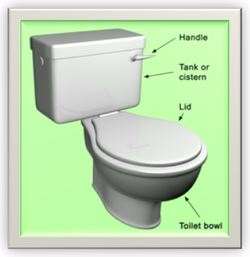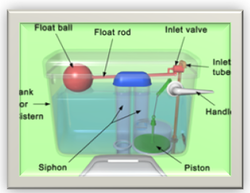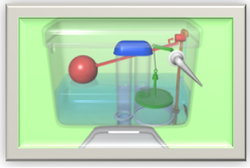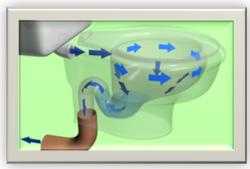The conventional flush toilet

A flush toilet disposes of our waste products by using water to send them through a drainpipe to another location.
The picture on the left shows a typical toilet. The toilet bowl usually has a ring-shaped seat on top, which is covered by the lid when not in use.
The handle, or sometimes a button, is pressed to flush the toilet. The water used for flushing is stored in the tank (also called a cistern).
The picture on the left shows a typical toilet. The toilet bowl usually has a ring-shaped seat on top, which is covered by the lid when not in use.
The handle, or sometimes a button, is pressed to flush the toilet. The water used for flushing is stored in the tank (also called a cistern).
How it works...
The tank

The tank contains some important parts.
The inlet valve controls the water supply coming into the tank. It lets water in when the tank is empty, and stops water coming in when the tank is full.
The float ball rises as the tank fills with water. As it rises, the float rod attached to it presses against the inlet valve. When the tank is full, the rod is pressing against the inlet valve hard enough to turn the water off. This stops the tank from overflowing.
The inlet valve controls the water supply coming into the tank. It lets water in when the tank is empty, and stops water coming in when the tank is full.
The float ball rises as the tank fills with water. As it rises, the float rod attached to it presses against the inlet valve. When the tank is full, the rod is pressing against the inlet valve hard enough to turn the water off. This stops the tank from overflowing.
Flushing

When you press the handle, a lever inside the tank pulls the piston up, forcing some water through the siphon. This provides suction in the siphon, and the rest of the water follows, emptying the tank.
The tank empties quite quickly, and the float ball floats to the bottom. That means the float rod is no longer pressing against the valve, so water begins to flow into the tank, filling it up again.
The tank empties quite quickly, and the float ball floats to the bottom. That means the float rod is no longer pressing against the valve, so water begins to flow into the tank, filling it up again.
Waste removal

The water which left the tank goes through a short pipe to the toilet bowl. It sloshes around the rim, down the sides of the bowl, and out through the drainpipe, cleaning the bowl and carrying the waste with it.
Some of the clean water coming behind remains at the bottom of the toilet bowl. That's because modern toilets have an 'S' bend which remains filled with water between flushing. The water in the 'S' bend stops bad odours escaping from the drainpipe. During flushing the 'S' bend also provides siphon action which helps speed up the flushing process.
Some of the clean water coming behind remains at the bottom of the toilet bowl. That's because modern toilets have an 'S' bend which remains filled with water between flushing. The water in the 'S' bend stops bad odours escaping from the drainpipe. During flushing the 'S' bend also provides siphon action which helps speed up the flushing process.
